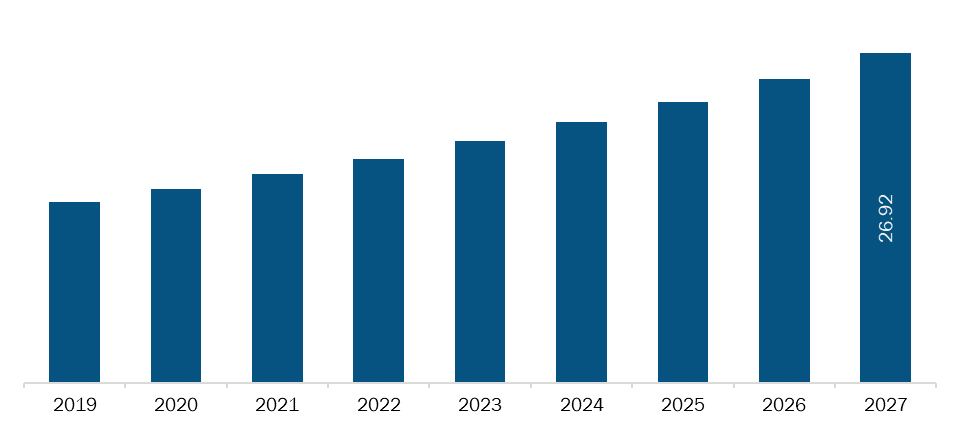The Asia Pacific Biodefense market is expected to reach US$ 723.70 Mn in 2027 from US$ 1,520.67 Mn in 2019. The market is estimated to grow with a CAGR of 9.8% from 2019-2027.
The growth of the Biodefense Market is driven by factors such as the favorable government initiatives increase in the number of naturally occurring outbreaks, increasing threat of biological weapons and nuclear armed ICBM in the Asia Pacific region. However, low R&D funding by government in developing and underdeveloped economies is likely to restrain the market growth to a certain extent.
Biodefense is referred to the measures taken to restore biosecurity of a group of organisms that are, or may be, subject to biological threats or infectious diseases. It is an effective public health care system with strong disease surveillance and rapid actions designed to counter biological threats, to limit the spread of disease and provide surge medical care.
Disease outbreaks of emerging infectious diseases are infections that have recently appeared within a population and are rapidly increasing or threaten to grow shortly. The SARS 2002-2003 epidemic appeared in November 2002 in the Guangdong province of southern China. This area is considered as a potential zone of re-emergence of SARS-CoV. Again, Human infections with an Asian lineage avian influenza A(H7N9) virus (“Asian H7N9”) were first reported in China in March 2013. The growing prevalence of Ebola and Zika virus infections is also likely to contribute to the market development. On 15 January 2020, the Ministry of Health, Labour and Welfare, Japan (MHLW) reported an imported case of laboratory-confirmed 2019-novel coronavirus (2019-nCoV) from Wuhan, Hubei Province, China. As of 30 March, 2020 Japan, reported 1,866 confirmed cases along with 74 deaths. Further, as of April 2020, China has approved three COVID-19 vaccine submissions for clinical trials, state-run Xinhua news agency quoted a Ministry of Science and Technology official.
The release of pathogenic agents such as anthrax or smallpox, biological toxins, chemical weapons such as nerve gas, or radioactive substances caused public threats in the past. In order to prevent such outbreaks, the government has planned various strategies. The growing prevalence of infectious diseases, such as coronavirus, Ebola and zika virus, is likely to boost the investments in the field of biodefense, thereby driving the Biodefense Market growth.
Biological weapons (BWs) deliver toxins and microorganisms, such as viruses and bacteria, so as to intentionally inflict disease among people, animals, and agriculture. Biological attacks can result in destruction of crops, temporarily discomforting a small community, killing large numbers of people, or other outcomes. Biological weapons have a long history of use. In 1346, the invading Tartar army catapulted the bodies of plague victims into the Crimean Peninsula city of Kaffa and infected its citizens. In 1763, British troops under General Jeffrey Amherst gave the Delaware Indians blankets used by people with smallpox, possibly infecting the susceptible native population. Japan contaminated food and released plague-infected ticks during their conflict with China during World War II. Although recent advances in biotechnology have made it easier to develop dangerous viruses, bacteria, and toxins with fewer resources. This has increased concerns that individuals and groups could resort to bioterrorism to attack a population. Hence, as the threat for biological weapon and nuclear armed ICBM is increasing, governments of various countries are actively funding for biodefense, thereby, positively propelling the Asia Pacific Biodefense Market.
Rest of Asia Pacific Biodefense market Revenue and Forecasts to 2027 (US$ Bn)

- This FREE sample will include data analysis, ranging from market trends to estimates and forecasts.
ASIA PACIFIC BIODEFENSE MARKET– MARKET SEGMENTATION
Asia Pacific Biodefense Market – By Product
- Anthrax
- Small pox
- Botulism
- Radiation/Nuclear
- Others
Asia Pacific Biodefense Market – By Country
- Japan
- China
- India
- South Korea
- Australia
Companies Mentioned
- Bavarian Nordic
- Alnylam Pharmaceuticals, Inc.
- SIGA Technologies
- Emergent BioSolutions Inc.
- Cleveland Bio Labs
- Dynavax Technologies
- Elusys Therapeutics, Inc.
- Soligenix
- Altimmune
- Pluristem Therapeutics
Asia Pacific Biodefense Report Scope
| Report Attribute | Details |
|---|---|
| Market size in 2019 | US$ 1,520.67 Million |
| Market Size by 2027 | US$ 723.70 Million |
| CAGR (2019 - 2027) | 9.8% |
| Historical Data | 2017-2018 |
| Forecast period | 2020-2027 |
| Segments Covered |
By Product
|
| Regions and Countries Covered |
Asia-Pacific
|
| Market leaders and key company profiles |
|
- Historical Analysis (2 Years), Base Year, Forecast (7 Years) with CAGR
- PEST and SWOT Analysis
- Market Size Value / Volume - Regional, Country
- Industry and Competitive Landscape
- Excel Dataset
Recent Reports
Testimonials
Reason to Buy
- Informed Decision-Making
- Understanding Market Dynamics
- Competitive Analysis
- Identifying Emerging Markets
- Customer Insights
- Market Forecasts
- Risk Mitigation
- Boosting Operational Efficiency
- Strategic Planning
- Investment Justification
- Tracking Industry Innovations
- Aligning with Regulatory Trends





















 Get Free Sample For
Get Free Sample For